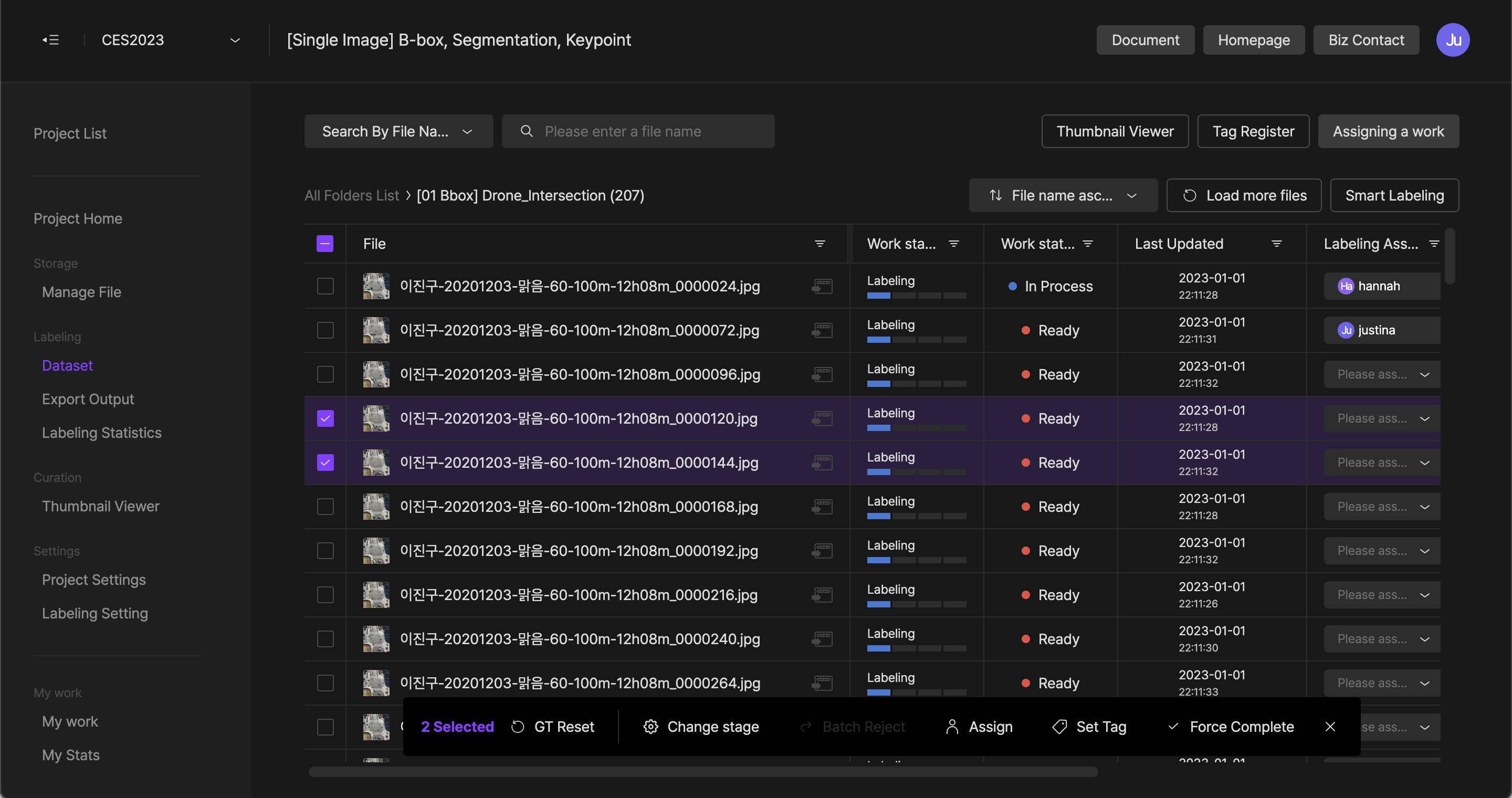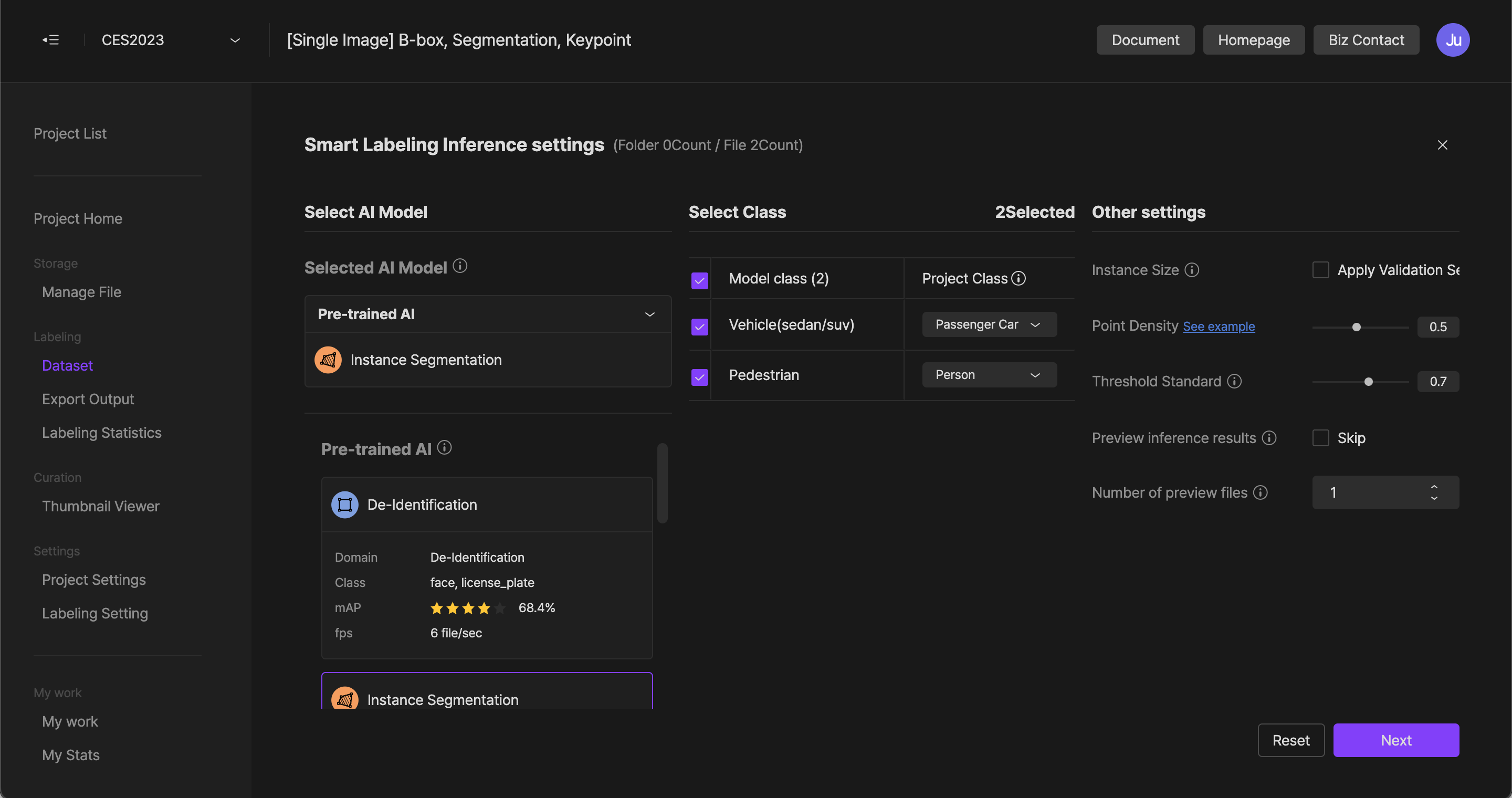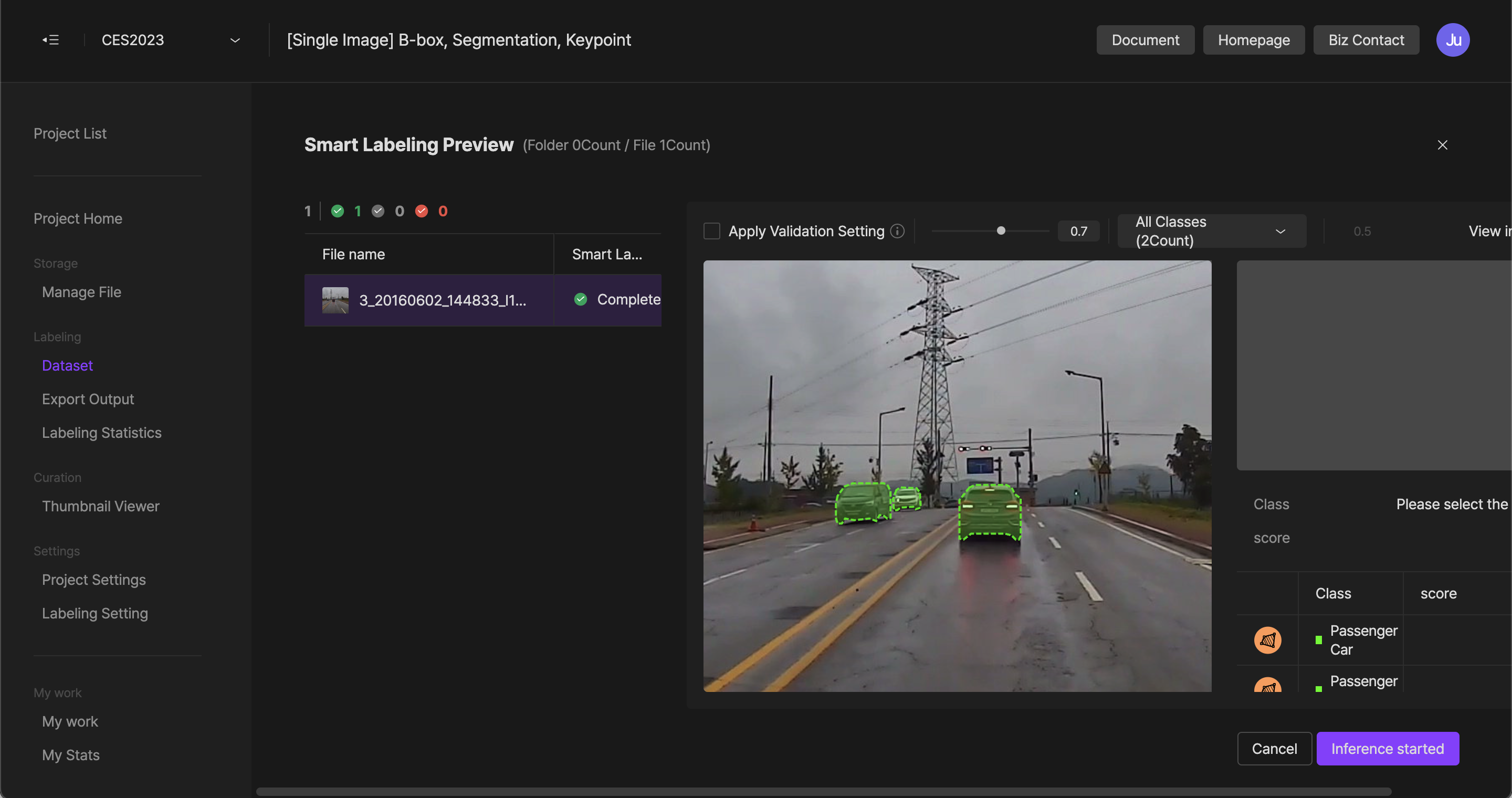Smart labeling
Smart labeling is a function that uses an AI model to label users’ data. By using AIMMO's AI model, labeling can be done faster and more efficiently.
Smart labeling type
AIMMO provides two types of smart labeling.
Preset AI
Preset AI is a labeling AI model trained based on data collected by AIMMO itself. All users who use AIMMO Enterprise services can use Preset AI to apply it to their data.
- Applicable project type
- Single Image: Bounding box, Poly segmentation, Polygon
- Sequence Image: Bounding box
- 3D Point Cloud : 3D cuboid
Custom AI
Custom AI is an AI model in that users self-train an AI model based on labeling data trained within the project. It accumulates a lot of labeling data in the field the user wants, and the performance can be improved as learning continues.
Custom AI training is not open during the open beta period (January-June 2023, 6 months). If you want to use it, please contact the AIMMO Business Team.
- Applicable project type
- Single Image: Bounding box, Poly segmentation
- Sequence Image: Bounding box
Smart labeling interference method
Apply at dataset
Smart labeling can be applied to Single Image and Sequence Image project types.
Apply smart labeling in units of folders or files (scene files).
After selecting the folder or file (scene file) you want to apply, select the Smart Labeling button at the top of the dataset.
Apply at the studio
You can apply smart labeling in 3D Point Cloud project types.
Apply smart labeling as a unit of frame
.
Select the Smart Labeling button on the left toolbar on the frame screen you want to apply.
Smart labeling inference application process
The process of applying smart labeling inference through a dataset is mainly carried out in four steps.
- Choose a target to apply within the dataset
- Set smart labeling inference
- Preview Smart Labeling
- Result of applying smart labeling
1. Select the application target within the dataset
Select the target (folder or file (scene file)) to apply smart labeling from the list of datasets.

- If you select a folder, all files under that folder will be applied.
- After selecting the target, select the 'Smart Labeling' button at the top of the dataset to move to the smart labeling inference setup process.
We provide inference for 100 files per workspace for free during the beta test period. If you want additional use, please contact AIMMO Business.
2. Set up smart labeling inference
You can set the necessary settings for smart labeling.
- Select the AI model
- Class matching of AI model provided class and project
- Other settings

1. Select the AI model
The types of AI models can be changed depending on the project type and task type set in the project.
- It is possible to select Custom AI only when there is a Custom AI created within the project or workspace.
Single Image
- Preset AI
- Bounding box: for general driving 1, for general driving 2, for general driving 3, for general objects 1, for general objects 2, for non-identification
- Poly segmentation: Semantic segmentation, Instance segmentation
- Polygon : OCR, OCR(Russian), OCR(Japanese)
- Custom AI
- Bounding box
- Poly segmentation: Semantic segmentation, Instance segmentation
Sequence Image
- Preset AI
- Bounding box: for general driving
- Custom AI
- Bounding box
2. Matching the class of AI model provision and project.
The class provided for each AI model will be changed. You can select a class set up in the project and an appropriate model and match the necessary items.
3. Other settings
Other settings required for smart labeling can be applied. Depending on the task type and model, the setting values that can be set may vary.
Whether validity setting value is applied or not
If you have added validity settings in labeling settings, you can apply them to check excluding unsuitable instances.
Threshold standard
Set the instance detection confidence threshold of the results inferred by the model. The higher the Threshold value is set; the more reliable instances are inferred.
Point density standard
when creating an instance of the poly segmentation type, set the standard value for the density (number) of points
Preview inference results
Before applying smart labeling, you can add a stage to preview the result obtained according to the set values.
Number of preview files
(Single Image type) You can set the number of files to be checked in the inference preview. It is available to set a maximum of 100 files.
Number of preview scene files
(Sequence Image type) You can set the number of scene files to check in the inference preview. Up to 10 scene files can be set.
Number of preview frames
(Sequence Image type) You can set the number of frames in the scene file that you can check in the inference preview. You can set up to 100 frames per scene file.
3. Preview Smart Labeling
In the preview stage, it is possible to check the instance derived according to the smart labeling setting value in advance.
After previewing, by selecting the Start Inference button, it is possible to apply inference to all selected files.

Preview File history
The history of files to which previews have been applied and the application result status are displayed as icons.
- Completion (Green): The smart labeling result of the file has been successfully applied.
- Error (Red): This appears when an error occurs while applying smart labeling to the file.
- No inference target (Gray): Smart labeling of the file was applied, but there is no inference target.
- Complex (Purple): The result of applying smart labeling to the corresponding scene file consists of a completed frame and no inference target frame. Displayed only for a scene file.
Preview window and instance history
It is available to check the images in the preview file and instances inferred by smart labeling.
If you select an instance history or thumbnail, you can check the thumbnail, class, and reliability information of the instance.
inference settings
You can adjust your inference settings by checking the preview screen directly.
- Apply validity setting value or not: If you have added validity settings in labeling settings, you can apply them to check and exclude unsuitable instances.
- Threshold standard: Set the instance detection confidence threshold of the results inferred by the model. The higher the Threshold value is set; the more reliable instances are inferred.
- Point density standard: Sets the standard value of the point density (number) when creating a poly segmentation type instance.
- Class filter: You can see this by filtering the applying interference class.
4. Smart labeling application result
Check the results of applying smart labeling in the dataset. The inference result is mainly divided into 4 states.

File list
- Completion (Green): The smart labeling result of the file has been successfully applied.
- Error (Red ): This appears when an error occurs while applying smart labeling to the file.
- No inference target (Gray): Smart labeling of the file was applied, but there is no inferred target.
- Complex (Purple): The result of applying smart labeling to the corresponding scene file consists of a completed frame and no inference target frame. Displayed only for a scene file.
folder list
- Completion (Green): The smart labeling results of all files in the folder have been successfully applied.
- Error (Red): This appears when an error occurs while applying smart labeling to all files in the folder.
- No inference target (Gray): Smart labeling has been applied to all files in the folder, but there is no interference target.
- Complex (Purple): All files in the folder are made up with at least 2 of the following statuses: 'Complete, Error, No Speculation Targets'. (Currently displayed only for the Sequence Image type.)
If you have any other inquiries, please get in touch with us at [email protected]
Updated 3 months ago